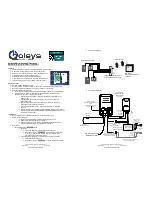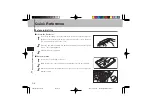
EXi: CX-3 Tonewheel Organ
218
emphasized. The Amp section interacts with
Expression; for more details, see “7–1a: Amp,” on
page 226.
To allow optimal modulation flexibility, the AMS
works differently from most other parameters. See
Mode
, below, for more details.
Expression Minimum
[0…30]
This specifies the minimum level when the Expression
Level parameter or Expression AMS are at 0.
Expression Level
[0…99]
This sets the default Expression level. It will be grayed
out if the
Mode
, below, is set to
Control Only
.
AMS
[List of AMS Sources]
This selects an AMS source to modulate Expression.
For a list of AMS sources, see “AMS (Alternate
Modulation Source) List” on page 967.
This parameter is grayed out if
Mode
, below, is set to
Level Only
.
NOTE
: The MIDI Expression controller (CC #11) is
hard-wired to scale the channel volume level. So,
despite the similar name, it’s best to use another
controller for as an AMS source.
Mode
[Level Only, AMS Only,
Both Scale, Both Overwrite]
This controls how the AMS interacts with the
programmed
Expression Level
.
Level Only
: The
Expression Level
parameter has
complete control over Expression. The
AMS
parameter
is grayed out and has no affect.
AMS Only
: The AMS input has complete control over
Expression, while the Expression Level parameter is
grayed out and has no affect.
Both Scale
: The values of
Expression Level
and AMS
are multiplied to produce the Expression level. For the
math-friendly, a value of 99 is treated as 1.0.
Both Overwrite
:
Expression Level
and
AMS
both
write directly to the Expression level. If the
Expression
Level
parameter is updated, it directly controls
Expression, and the last value from AMS is ignored. If
the AMS input moves, it also directly controls
Expression, and the setting of the
Expression Level
parameter is ignored.
4–2c: Wheel Brake
Tone wheel organs actually have physical wheels,
which gradually come up to speed when you turn the
power on, and gradually slow to a stop when you turn
the power off. As the wheels rotate more quickly, the
pitch rises; as they slow down, the pitch falls.
This section models this behavior, for use as a special
effect.
Wheel Brake
[Off, On]
This parameter allows you to manually control the
Wheel Brake. Off is the default; the tone wheels will
turn normally. Changing this to On will make the tone
wheels gradually slow down, and eventually stop
altogether.
AMS
[List of AMS sources]
This selects an AMS source to control the Wheel Brake.
For a list of AMS sources, see “AMS (Alternate
Modulation Source) List” on page 967.
AMS Mode
[Toggle, Momentary]
This parameter controls the way in which the Wheel
Brake AMS works.
When this is set to
Toggle
, the Wheel Brake AMS will
alternate between “power on” and “power off.” For
instance, if
Wheel Brake
is set to
Off
, and
AMS
is
assigned to a footswitch, the first press will cause the
wheel rotation to slow, and the next press will bring
them back up to speed again.
Momentary
means that the power is turned “off” only
while the controller is enabled. Continuing the
example from above, when the footswitch is pressed
down, the wheel rotation will slow down; when the
footswitch is released, the wheel rotation will speed up
again.
AMS lets you switch to the opposite of the
programmed setting. For instance, if
Wheel Brake
is
set to
On
(unlikely but possible!), and the
AMS Mode
is set to
Momentary
, then pressing down on the
footswitch would cause the tone wheels to come up to
speed.
If you set AMS to use a continuous controller, such as
the Joystick, values of 0-63 are as if the switch was off,
and values of 64–127 are as if the switch was on.
Finally - note that the assignable switches,
SW1
and
SW2
, can themselves be set to either momentary or
toggle modes, and these settings are reflected by the
switch LEDs. Individual parameter mode settings,
such as the Wheel Brake AMS Mode, do
not
affect the
LEDs.
So, if you’re using SW1 or SW2 as the AMS source, it’s
best to set the AMS Mode to Momentary, and then just
let the switch itself determine the momentary/toggle
behavior.
Wheel Brake Speed
[Slow, Fast]
This controls the speed at which the wheels will slow
down and speed up.
▼
4–2: Page Menu Commands
The number before each command shows its ENTER +
number-key shortcut. For more information on these
shortcuts, see “ENTER + 0-9: shortcuts for menu
commands” on page 138.
• 0:
Write Program
. For more information, see “Write
• 1:
Exclusive Solo
. For more information, see
Содержание Electronic Keyboard
Страница 1: ...Parameter Guide Parameter Guide ...
Страница 2: ......
Страница 180: ...Program mode EXi 170 ...
Страница 290: ...EXi STR 1 Plucked String 280 ...
Страница 572: ...Sequencer mode 562 ...
Страница 700: ...Global mode 690 ...
Страница 751: ...Insert Effects IFX1 IFX12 Routing 741 Fig 2 3a Fig 2 3b ...
Страница 902: ...Effect Guide 892 ...
















































